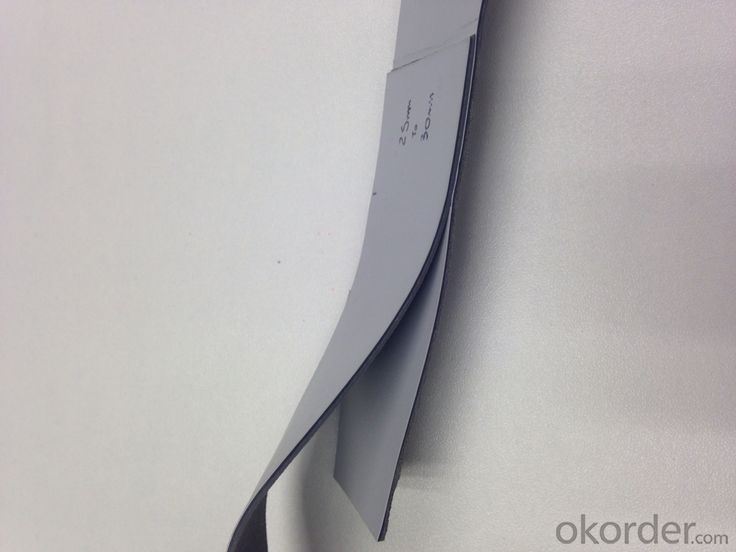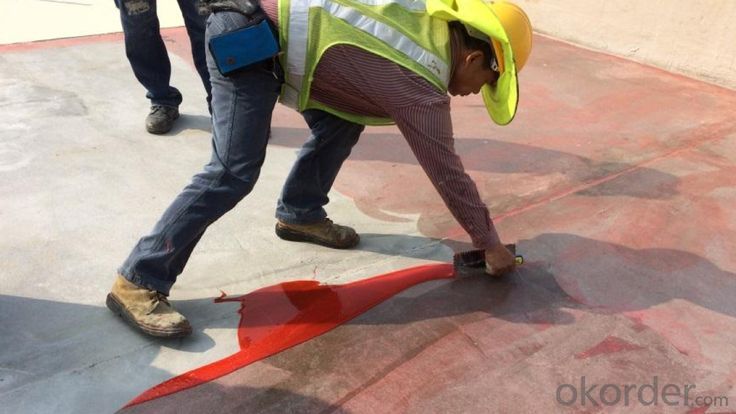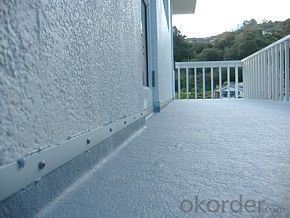PVC Waterproof Membrane for Outdoor Exhibition Hall High Tensile Strength
- Loading Port:
- Tianjin
- Payment Terms:
- TT OR LC
- Min Order Qty:
- 2000 m²
- Supply Capability:
- 10000 m²/month
OKorder Service Pledge
OKorder Financial Service
You Might Also Like
Product description
The PVC waterproofing rolls formulas are based upon polyvinyl chloride resin with other assistants added to provide flexibility and stability such as anti-oxidant,absorbent of ultraviolet light, plasticizer and plastic filling agent.
Application Scope
The products are widely used in all kinds of civil construction,subway,tunnel,water conservancy,landfill site,chemical industry,metallurgy and other areas of waterproof seepage control,corrosion engineering
Features:
Excellent anti-aging property.
Puncture- resistant.
Welding construction,
High tensile strength, good elongation, good dimensional stability.
Good plasticity.
It has self-extinguishing from fire property.
Materials surface is smooth, fast color, stain resistance.
More wide, Wastage become less when being used.
Type:
N1—Exposed PVC waterproof membrane.
(It is mainly used as details treatment for exposed roof waterproof project)
N2—Non-exposed PVC waterproof membrane.
(It is mainly used as details treatment for non-exposed roof waterproof project)
L1—Exposed PVC waterproof membrane with fabric
(It is mainly used for exposed roof waterproof project)
L2—Non-exposed PVC waterproof membrane with fabric.
(It is mainly used for non-exposed roof waterproof project)
W1—Exposed reinforced PVC waterproof membrane .
(It is mainly used for steel structure roof exposed waterproof project)
W2—Exposed reinforced PVC waterproof membrane .
(It is mainly used for steel structure roof non-exposed waterproof project)
Advantages

Technical Parameters
No. | Item | Index | |||||
| 1 | Thickness of resin layer of the middle fabric ,mm≥ | - | - | 0.40 | 0.40 | 0.40 | |
| 2 | Tensile performance | Max tensile strength,N/cm ≥ | - | 120 | 250 | - | 120 |
| Tensile strength,NPa ≥ | 10 | - | -10 | - | - | ||
| Max elongation% ≥ | - | - | 15 | - | - | ||
| Breaking elongation % ≥ | 200 | 150 | - | 200 | 100 | ||
| 3 | Heat treatment size change rate%≤ | 2.0 | 1.0 | 0.5 | 0.1 | 0.1 | |
| 4 | Cold bonding | -25°c No cracks | |||||
| 5 | Watertightness | 0.3mPa,2h waterproof | |||||
Packaging & Shipping

product show












FAQ
Q: What's the delivery time ?
A: 3-5 days for 1-600 rolls, 10-15 days for container.
Q: What's the payment terms ?
A: TT/LC
Q: How do you make replacement with quality problems ?
A: New replacement will be packed into your next order or send to you directly after receive video or photo about quality problems.
- Q: Can a waterproofing membrane be used in areas with vehicular traffic?
- Yes, a waterproofing membrane can be used in areas with vehicular traffic. In fact, there are specific types of waterproofing membranes designed to withstand the weight and movement of vehicles. These membranes, known as vehicular membranes or traffic-bearing membranes, are usually made of more durable materials such as rubberized asphalt or modified bitumen. They are designed to provide a strong and flexible barrier against water and moisture while also being able to handle the heavy loads and constant traffic associated with vehicles. Vehicular membranes are commonly used in parking garages, bridges, and other areas where vehicles are present.
- Q: Can a waterproofing membrane be used for a rooftop garden protection?
- Indeed, rooftop garden protection can be achieved through the utilization of a waterproofing membrane. Specifically formulated to impede water penetration, this type of membrane proves to be an optimal selection for safeguarding a rooftop garden. By establishing a protective barrier, it effectively bars water infiltration, thus averting any possible harm to both the rooftop's structure and the garden's flora. Furthermore, certain membranes provide supplementary advantages, including resistance to UV rays and roots, thereby augmenting their suitability for the safeguarding of rooftop gardens.
- Q: Can a waterproofing membrane be used in coastal areas?
- Yes, a waterproofing membrane can be used in coastal areas. Coastal areas are prone to high levels of moisture and water exposure, making it essential to have effective waterproofing measures in place. A waterproofing membrane, when properly installed and maintained, can provide a protective barrier against water intrusion, preventing damage to structures and ensuring their durability. However, it is important to select a membrane that is specifically designed for coastal environments, as these membranes are typically more resistant to saltwater and have enhanced durability to withstand the harsh coastal conditions. Additionally, regular inspection and maintenance should be carried out to ensure the effectiveness of the waterproofing membrane in coastal areas.
- Q: Can a waterproofing membrane be used for wastewater treatment plants or sewage facilities?
- Indeed, wastewater treatment plants and sewage facilities require protection against water infiltration and leakage due to the abundance of water and potentially corrosive substances. To address this issue, a versatile solution in the form of a waterproofing membrane can be utilized. This membrane acts as a barrier, preventing water penetration and safeguarding the structure from damage while ensuring the facility's proper functioning. Its application extends to various areas such as walls, floors, roofs, and tanks, effectively maintaining a watertight environment and prolonging the facility's lifespan. Moreover, certain waterproofing membranes are specifically engineered to withstand harsh chemicals, making them ideal for wastewater treatment plants and sewage facilities where corrosive substances may be present.
- Q: Can a waterproofing membrane be used for underground parking structures?
- Yes, a waterproofing membrane can be used for underground parking structures. Underground parking structures are particularly vulnerable to water infiltration due to their location and exposure to groundwater. Waterproofing membranes are designed to provide a protective barrier against water penetration, preventing potential damage to the structure and its contents. These membranes are typically applied to the exterior walls and floors of the underground parking structure, ensuring a watertight seal. Additionally, the use of a waterproofing membrane can also help to prevent the formation of moisture-related issues such as mold growth, corrosion, and deterioration of concrete. Therefore, incorporating a waterproofing membrane is essential for the long-term durability and functionality of underground parking structures.
- Q: Can a waterproofing membrane be used on precast metal surfaces?
- Precast metal surfaces can benefit from the application of a waterproofing membrane. These membranes are specifically designed to create a protective layer that stops water from penetrating the surface. They can be used on various types of surfaces, including precast metal. Waterproofing membranes are typically made from materials like bitumen, liquid coatings, or synthetic rubber. These materials form a barrier that prevents water and moisture from causing damage. When a waterproofing membrane is applied to precast metal surfaces, it helps to prevent corrosion, protects against water damage, and improves the overall durability and lifespan of the metal structure. However, it is crucial to select a waterproofing membrane that is compatible with the specific type of precast metal surface. Additionally, proper surface preparation and application techniques must be followed to ensure optimal performance.
- Q: Can a waterproofing membrane be used for fire pit areas?
- No, a waterproofing membrane should not be used for fire pit areas. While waterproofing membranes are designed to prevent water penetration, they are not designed to withstand the high temperatures and potential fire hazards associated with fire pits. Fire pit areas require specific fire-resistant materials that can withstand the heat generated by the fire and prevent any potential fire accidents. It is important to use appropriate materials that are specifically designed for fire pit areas to ensure safety and prevent any potential damage.
- Q: Can waterproofing membranes be used on concrete slabs?
- Yes, waterproofing membranes can be used on concrete slabs. These membranes are designed to provide a protective barrier against water infiltration and can effectively prevent moisture from seeping into the concrete.
- Q: Whether the polyester waterproofing membrane can be used for roofing waterproofing
- 2, roof waterproofing is not just a layer of waterproof membrane, according to the design of the coating is usually used waterproof layer + polyester membrane waterproof layer;
- Q: Can a waterproofing membrane be used for roofing applications?
- Yes, a waterproofing membrane can be used for roofing applications. Waterproofing membranes are specifically designed to prevent water infiltration, making them ideal for protecting roofs from leaks and water damage. They provide a durable and effective barrier against moisture, ensuring the roof remains watertight.
Send your message to us
PVC Waterproof Membrane for Outdoor Exhibition Hall High Tensile Strength
- Loading Port:
- Tianjin
- Payment Terms:
- TT OR LC
- Min Order Qty:
- 2000 m²
- Supply Capability:
- 10000 m²/month
OKorder Service Pledge
OKorder Financial Service
Similar products
Hot products
Hot Searches
Related keywords
































